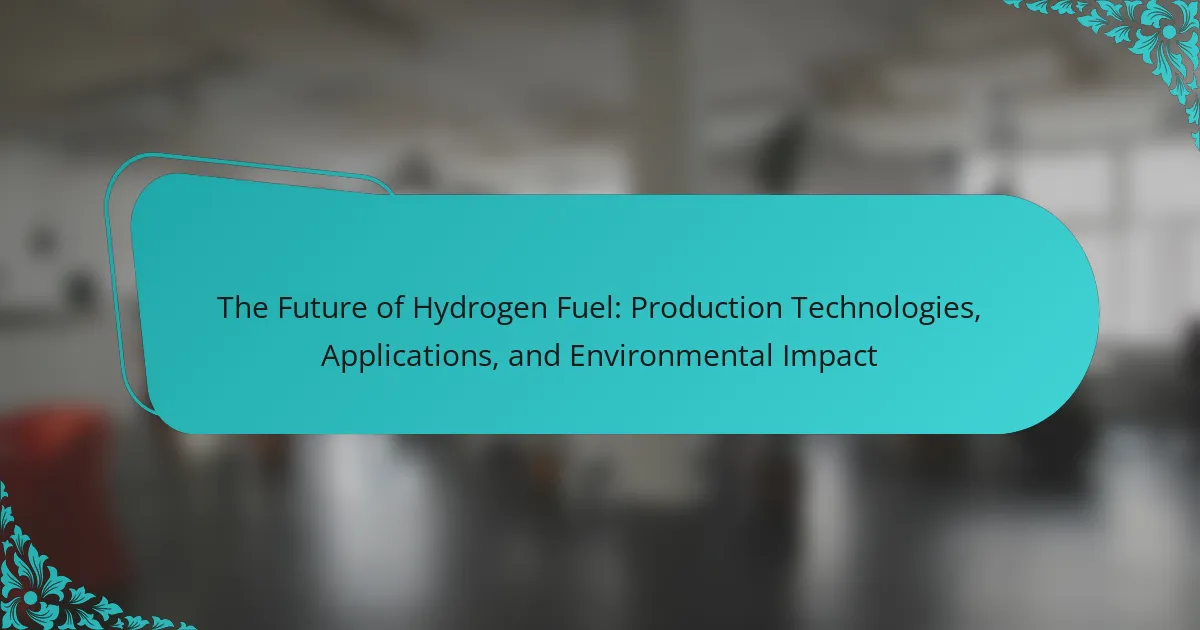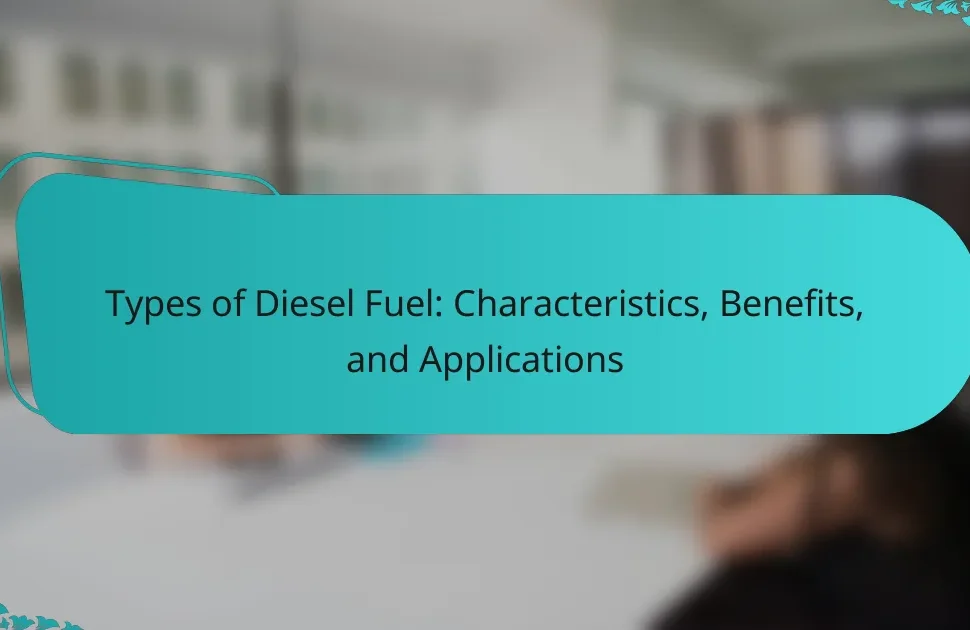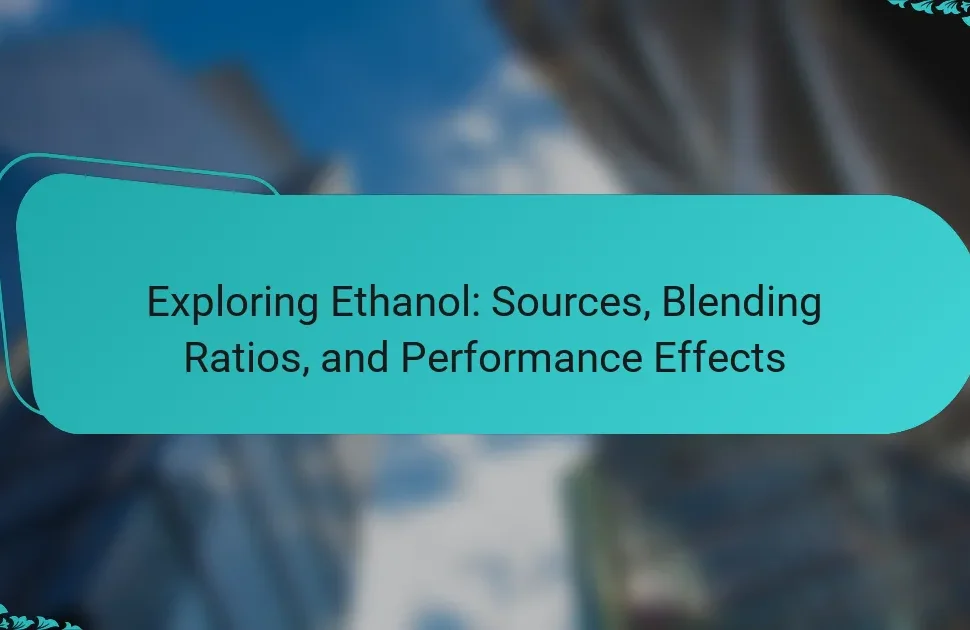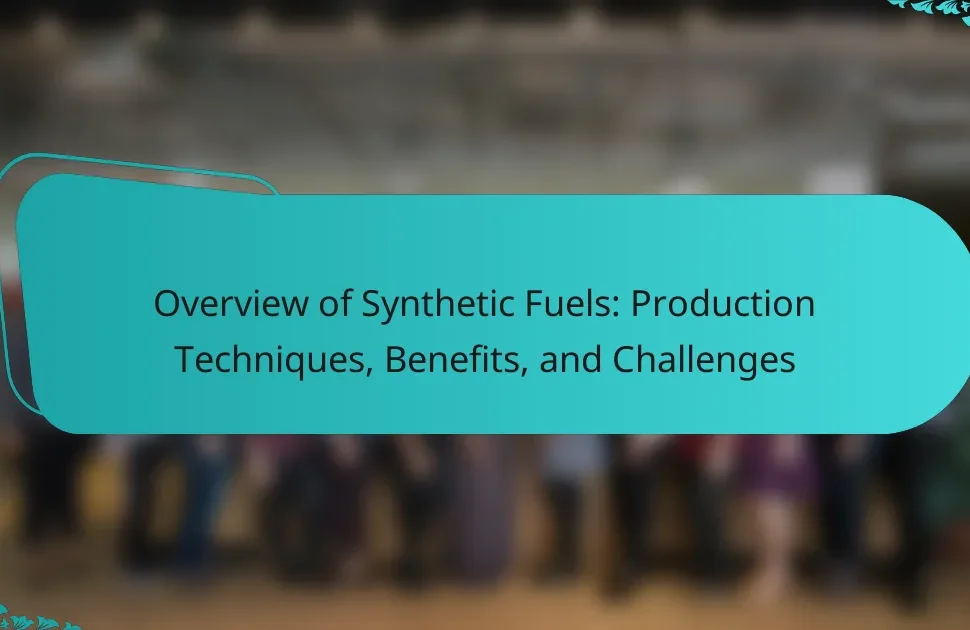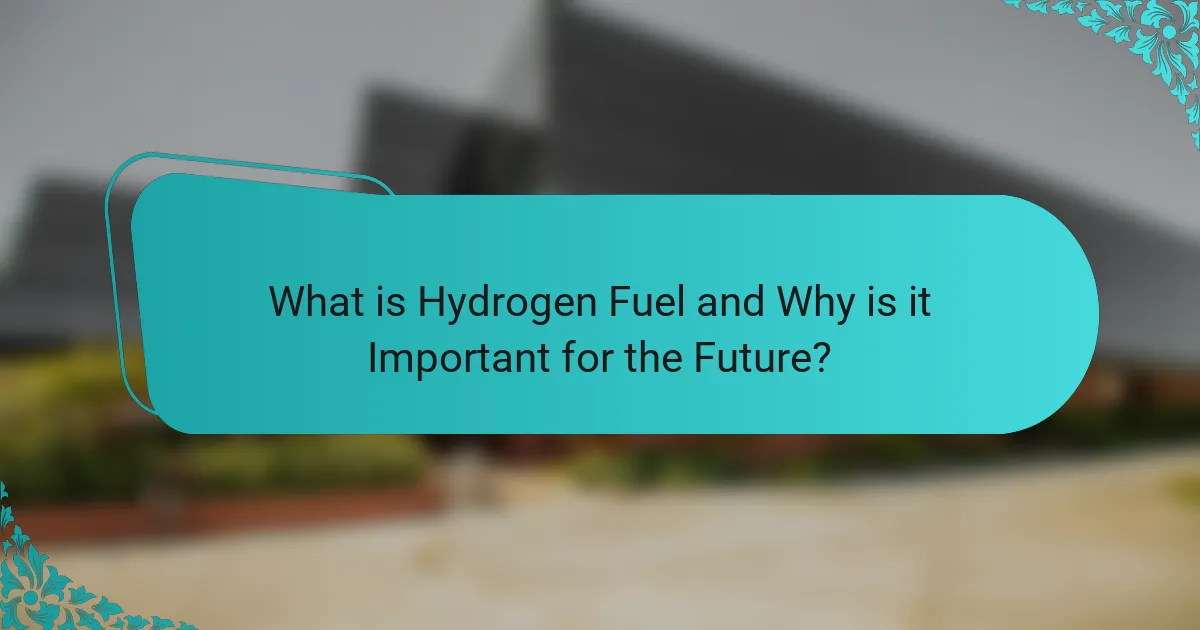
What is Hydrogen Fuel and Why is it Important for the Future?
Hydrogen fuel is a clean energy source produced from hydrogen gas. It can be used in fuel cells to generate electricity with water as the only byproduct. Hydrogen fuel is important for the future due to its potential to reduce greenhouse gas emissions. It offers an alternative to fossil fuels, helping to combat climate change. The global hydrogen market is projected to reach $200 billion by 2025, indicating significant growth potential. Additionally, hydrogen can be produced from various renewable sources, enhancing energy security. Its versatility allows applications in transportation, industry, and power generation. As countries aim for carbon neutrality, hydrogen fuel plays a crucial role in achieving these goals.
How is Hydrogen Fuel produced?
Hydrogen fuel is produced primarily through methods such as steam methane reforming, electrolysis, and gasification. Steam methane reforming involves reacting natural gas with steam to produce hydrogen and carbon dioxide. This method accounts for about 95% of hydrogen production globally. Electrolysis uses electricity to split water into hydrogen and oxygen. It is a cleaner method when powered by renewable energy sources. Gasification converts organic materials into hydrogen by applying heat and pressure in a low-oxygen environment. Each method varies in efficiency and environmental impact, influencing its adoption in future hydrogen fuel applications.
What are the various production technologies for Hydrogen Fuel?
Hydrogen fuel can be produced through several key technologies. These include steam methane reforming, which is the most common method, converting natural gas into hydrogen. Electrolysis is another technology, where electricity splits water into hydrogen and oxygen. Gasification of biomass also produces hydrogen by converting organic materials at high temperatures. Thermochemical cycles use heat to drive chemical reactions that generate hydrogen. Lastly, photoelectrochemical water splitting employs sunlight to produce hydrogen from water. Each method varies in efficiency and environmental impact, influencing the future of hydrogen fuel production.
How do these technologies compare in terms of efficiency and cost?
Hydrogen production technologies vary significantly in efficiency and cost. Electrolysis is generally more efficient than steam methane reforming (SMR) but has higher operational costs. Electrolysis can achieve efficiencies of 60-80%, while SMR typically operates at 70-85% efficiency. However, SMR has lower initial capital costs, making it more economically viable for large-scale production. According to the International Energy Agency, the cost of hydrogen from SMR is around $1.5 to $3.0 per kilogram, while electrolysis can range from $3.0 to $6.0 per kilogram depending on electricity prices. Therefore, while electrolysis offers higher efficiency, its cost can be prohibitive compared to SMR.
What are the key applications of Hydrogen Fuel?
Hydrogen fuel has key applications in various sectors. It is primarily used in transportation, particularly in fuel cell vehicles. These vehicles convert hydrogen into electricity, producing only water as a byproduct. Hydrogen is also utilized in industrial processes, such as refining petroleum and producing ammonia for fertilizers. Additionally, it serves as an energy storage solution, allowing excess renewable energy to be stored and used later. Hydrogen can be blended with natural gas for heating and electricity generation. In the aerospace industry, it powers rockets and other aircraft. The versatility of hydrogen fuel makes it a crucial player in the transition to cleaner energy systems.
How is Hydrogen Fuel used in transportation?
Hydrogen fuel is used in transportation primarily as a clean energy source for fuel cell vehicles. Fuel cell vehicles convert hydrogen into electricity, powering electric motors. This process emits only water vapor as a byproduct, making it environmentally friendly. Hydrogen can be stored in high-pressure tanks within vehicles. It can also be produced on-site at hydrogen refueling stations. The use of hydrogen fuel in transportation reduces reliance on fossil fuels. According to the U.S. Department of Energy, hydrogen fuel cell vehicles can achieve ranges comparable to gasoline vehicles. Additionally, major automotive manufacturers are investing in hydrogen technology, indicating a growing market.
What role does Hydrogen Fuel play in energy storage?
Hydrogen fuel serves as a key medium for energy storage. It allows for the conversion of surplus renewable energy into a storable form. This is particularly useful when energy generation exceeds demand. Hydrogen can be produced through electrolysis, where water is split into hydrogen and oxygen using electricity. The stored hydrogen can later be converted back into electricity using fuel cells. This process enables the balancing of energy supply and demand. Studies indicate that hydrogen can store energy efficiently, with a high energy density of about 33.6 kWh/kg. Additionally, hydrogen storage solutions can be scaled to meet varying energy needs.
What are the environmental impacts of Hydrogen Fuel?
Hydrogen fuel has both positive and negative environmental impacts. On the positive side, when hydrogen is burned, it produces only water vapor as a byproduct, reducing greenhouse gas emissions compared to fossil fuels. Additionally, hydrogen can be produced from renewable resources, such as water electrolysis using solar or wind energy, which minimizes carbon footprints.
However, the production of hydrogen can also have significant environmental drawbacks. If derived from natural gas through steam methane reforming, it emits carbon dioxide, contributing to climate change. Furthermore, large-scale hydrogen production can require substantial water resources, which may strain local water supplies.
The overall environmental impact of hydrogen fuel depends on the production method used. Studies indicate that green hydrogen, produced from renewable energy, offers the most environmentally friendly option. Conversely, hydrogen from fossil fuels presents challenges that could negate its benefits.
How does Hydrogen Fuel contribute to reducing carbon emissions?
Hydrogen fuel contributes to reducing carbon emissions by serving as a clean energy source. When hydrogen is used in fuel cells, it produces only water vapor as a byproduct. This contrasts with fossil fuels, which emit carbon dioxide and other greenhouse gases when burned. Hydrogen can be produced from renewable sources, such as water through electrolysis, which further minimizes its carbon footprint. According to the International Energy Agency, transitioning to hydrogen could reduce greenhouse gas emissions significantly. In fact, hydrogen has the potential to cut global emissions by up to 6 gigatons by 2050. Thus, utilizing hydrogen fuel can play a crucial role in combating climate change.
What are the potential risks associated with Hydrogen Fuel production and use?
The potential risks associated with hydrogen fuel production and use include safety hazards, environmental concerns, and economic factors. Hydrogen is highly flammable, which poses explosion risks during production and storage. The production methods, particularly steam methane reforming, can release significant carbon emissions. Additionally, the transportation of hydrogen can lead to leaks, contributing to greenhouse gas emissions. Economic risks arise from the high costs of production and infrastructure development. These factors must be carefully managed to ensure safe and sustainable hydrogen fuel utilization.
What challenges does Hydrogen Fuel face in becoming mainstream?
Hydrogen fuel faces several challenges in becoming mainstream. One major challenge is the high cost of production. Current methods, such as steam methane reforming, are expensive and rely on fossil fuels. Another challenge is the lack of infrastructure for distribution and storage. There are limited hydrogen refueling stations available, which hampers adoption. Safety concerns also play a significant role. Hydrogen is highly flammable, requiring stringent safety measures. Additionally, there are efficiency issues in converting hydrogen to energy. Fuel cells have lower efficiencies compared to traditional batteries. Lastly, public perception and awareness of hydrogen technology remain low. Many consumers are unfamiliar with its benefits and applications.
What are the technological barriers to Hydrogen Fuel adoption?
The technological barriers to hydrogen fuel adoption include high production costs, storage challenges, and limited infrastructure. Hydrogen production methods, such as electrolysis, can be expensive due to energy requirements. Additionally, hydrogen has a low energy density, making storage and transport difficult. Current storage solutions often require high pressures or cryogenic temperatures, which complicates logistics. Furthermore, the existing refueling infrastructure for hydrogen vehicles is sparse. According to the U.S. Department of Energy, there are only about 50 hydrogen refueling stations in the U.S. This limited availability hinders consumer adoption. Overall, these barriers contribute to slow progress in hydrogen fuel integration into the energy market.
How do economic factors influence the growth of the Hydrogen Fuel market?
Economic factors significantly influence the growth of the Hydrogen Fuel market. Investment levels directly affect research and development in hydrogen technologies. Higher investments lead to advancements in production efficiency and cost reduction. Market demand is also driven by the cost of alternative energy sources. When fossil fuel prices rise, hydrogen becomes a more attractive option. Government policies and subsidies further enhance market growth by supporting hydrogen projects. Countries with strong renewable energy initiatives are seeing increased hydrogen adoption. Economic stability and consumer awareness additionally play crucial roles in market expansion. According to the International Energy Agency, global hydrogen demand could reach 500 million tons by 2050, influenced largely by these economic factors.
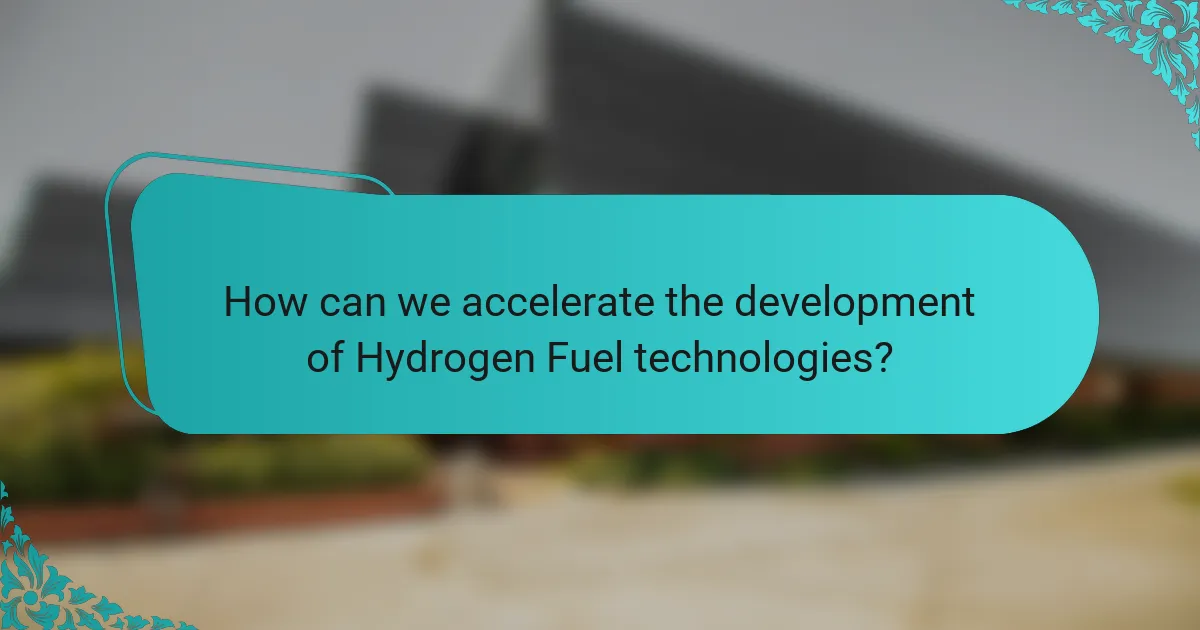
How can we accelerate the development of Hydrogen Fuel technologies?
Investing in research and development can accelerate the development of hydrogen fuel technologies. Increased funding can lead to breakthroughs in production methods. For instance, enhancing electrolysis efficiency is crucial. Current electrolysis methods convert only about 70-80% of energy into hydrogen. Innovations could push this efficiency above 90%.
Collaboration between governments and private sectors is vital. Public-private partnerships can share resources and knowledge. This collaboration can also facilitate large-scale pilot projects. Demonstrating hydrogen technologies in real-world applications can build public trust and interest.
Additionally, improving infrastructure is essential. Developing hydrogen storage and distribution systems will support widespread adoption. Countries like Germany are already investing in hydrogen refueling stations. This infrastructure is necessary for the transition to hydrogen as a mainstream fuel.
Finally, regulatory frameworks must evolve. Clear policies can encourage investment and innovation in hydrogen technologies. Overall, these strategies can significantly speed up the development of hydrogen fuel technologies.
What policies support the growth of Hydrogen Fuel?
Government policies supporting the growth of hydrogen fuel include subsidies, tax incentives, and research funding. Subsidies lower production costs, making hydrogen more competitive. Tax incentives encourage private investment in hydrogen technologies. Research funding supports innovation in production and storage methods. These policies aim to reduce greenhouse gas emissions and promote energy security. Countries like Germany and Japan have implemented national hydrogen strategies. These strategies include infrastructure development and international collaboration. Such initiatives enhance the market for hydrogen fuel and drive technological advancements.
How do government incentives impact Hydrogen Fuel production?
Government incentives significantly enhance hydrogen fuel production. These incentives can take various forms, including tax credits, grants, and subsidies. They lower the financial barriers for companies investing in hydrogen technologies. For instance, the U.S. government allocated $1.5 billion to hydrogen projects under the Bipartisan Infrastructure Law. Such funding encourages research and development in hydrogen production methods. Additionally, incentives can stimulate public-private partnerships, fostering innovation. Countries like Germany have implemented feed-in tariffs to promote renewable hydrogen. This has led to increased production capacities and reduced costs. Overall, government incentives create a favorable environment for the growth of the hydrogen fuel sector.
What role do international agreements play in Hydrogen Fuel development?
International agreements are crucial for hydrogen fuel development. They facilitate collaboration among countries to establish common standards. These agreements promote research and investment in hydrogen technologies. They also help in sharing best practices and innovations. For example, the Paris Agreement encourages nations to reduce carbon emissions. This includes transitioning to cleaner energy sources like hydrogen. International partnerships can lead to shared funding for hydrogen projects. They also create markets for hydrogen through trade agreements. Such cooperation accelerates the global adoption of hydrogen as a sustainable energy solution.
How can public perception of Hydrogen Fuel be improved?
Public perception of hydrogen fuel can be improved through education and awareness campaigns. These campaigns should focus on the environmental benefits of hydrogen fuel, such as its potential to reduce greenhouse gas emissions. According to the U.S. Department of Energy, hydrogen fuel can produce zero emissions at the point of use. Demonstrating successful hydrogen projects can also enhance credibility. For example, hydrogen fuel cell vehicles have been successfully deployed in various regions, showcasing their practicality. Collaborations with trusted organizations can further validate claims and increase public trust. Engaging communities through workshops and demonstrations can provide firsthand experience and understanding. Clear communication of safety measures related to hydrogen production and use is essential. Transparency about the production processes and renewable sources can also address concerns about sustainability.
What educational initiatives can enhance understanding of Hydrogen Fuel?
Educational initiatives that can enhance understanding of Hydrogen Fuel include workshops, online courses, and public awareness campaigns. Workshops provide hands-on experience with hydrogen technologies. Online courses can cover the science and applications of hydrogen fuel. Public awareness campaigns can inform the community about hydrogen’s benefits and safety. Educational institutions can integrate hydrogen fuel topics into existing curricula. Collaborations with industry experts can bring real-world insights to students. Research projects can involve students in practical applications of hydrogen fuel. These initiatives can increase knowledge and promote innovation in hydrogen technologies.
How can successful case studies influence public opinion?
Successful case studies can significantly influence public opinion by providing concrete examples of effectiveness and benefits. They showcase successful implementations that resonate with the audience. For instance, case studies on hydrogen fuel projects demonstrate feasibility and environmental advantages. These examples can shift perceptions and encourage acceptance of new technologies. Public confidence often increases when people see tangible results. Research shows that 70% of individuals are more likely to support initiatives backed by successful case studies. Such data highlights the persuasive power of real-world evidence in shaping opinions.
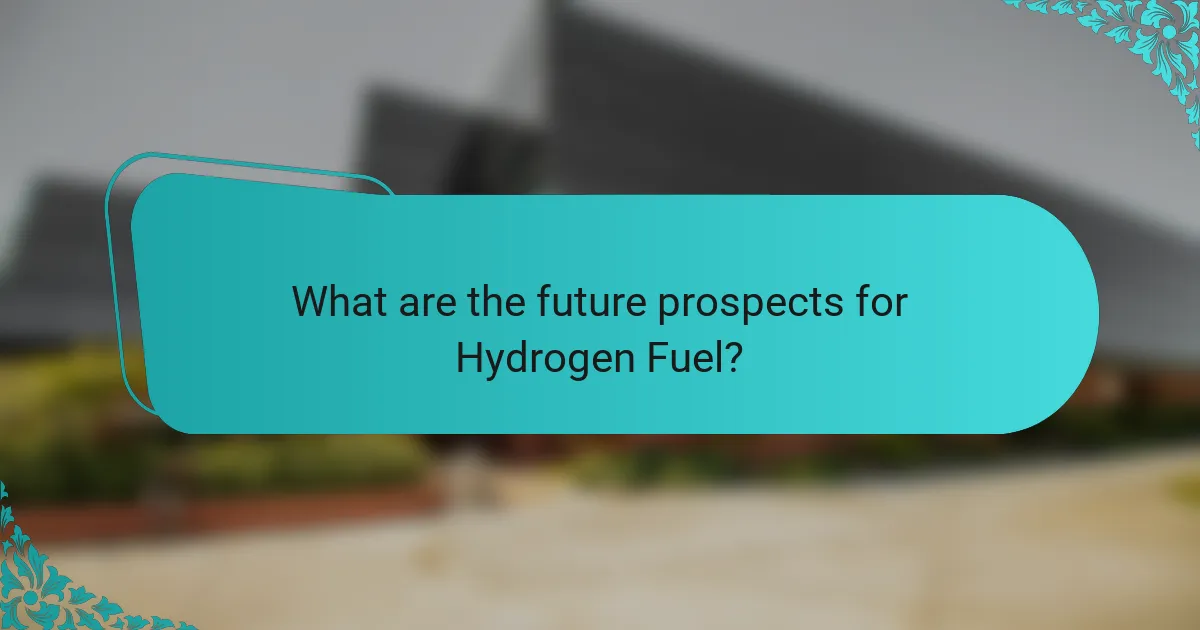
What are the future prospects for Hydrogen Fuel?
The future prospects for hydrogen fuel are promising due to its potential as a clean energy source. Hydrogen fuel can significantly reduce greenhouse gas emissions when produced from renewable sources. The global hydrogen market is expected to grow from $135 billion in 2021 to over $200 billion by 2025, indicating strong demand. Governments and industries are investing in hydrogen infrastructure and technologies. For example, the European Union has committed to a hydrogen strategy that aims for 40 gigawatts of electrolyzer capacity by 2030. Additionally, hydrogen can play a crucial role in decarbonizing sectors like transportation and heavy industry. Companies like Toyota and Hyundai are already developing hydrogen fuel cell vehicles. Overall, advancements in production methods and increasing investments are enhancing the viability of hydrogen fuel in the energy landscape.
What innovations are on the horizon for Hydrogen Fuel technologies?
Innovations on the horizon for hydrogen fuel technologies include advancements in electrolysis and fuel cell efficiency. New electrolysis methods utilize renewable energy sources to enhance hydrogen production. Researchers are developing solid oxide electrolysis cells that operate at higher temperatures. This can significantly reduce energy consumption.
Additionally, improvements in fuel cell technology are making them more efficient and affordable. Companies are working on hydrogen storage solutions that increase safety and reduce costs. Innovations in hydrogen transport are also being explored to ensure effective distribution.
These innovations are supported by significant investments in hydrogen infrastructure globally. For instance, the Hydrogen Council reports a projected investment of over $300 billion by 2030. This funding aims to accelerate the commercialization of hydrogen technologies.
How might advancements in electrolysis change Hydrogen Fuel production?
Advancements in electrolysis can significantly improve hydrogen fuel production. Enhanced electrolysis technologies can increase efficiency and reduce costs. For instance, new catalysts can lower energy requirements for the process. This leads to more sustainable hydrogen generation from renewable sources. Improved electrolysis methods can also increase the purity of hydrogen produced. Higher purity is essential for fuel cell applications. Additionally, advancements may enable on-site hydrogen production, reducing transportation needs. Research indicates that optimizing electrolysis can lead to a 30% reduction in operational costs. Overall, these advancements position electrolysis as a key player in the future of hydrogen fuel production.
What emerging applications could drive demand for Hydrogen Fuel?
Emerging applications that could drive demand for hydrogen fuel include transportation, industrial processes, and energy storage. In transportation, hydrogen fuel cells can power vehicles, offering zero emissions compared to traditional fuels. The global hydrogen fuel cell vehicle market is projected to grow significantly, with estimates suggesting a compound annual growth rate of over 30% by 2027.
In industrial processes, hydrogen is increasingly used for steel production as a cleaner alternative to coal. The steel industry accounts for approximately 7% of global CO2 emissions, making hydrogen a critical component in reducing this footprint.
Energy storage applications also present a significant opportunity. Hydrogen can store excess renewable energy, providing a solution for intermittent energy sources like wind and solar. The global market for hydrogen storage solutions is expected to reach $20 billion by 2025, reflecting growing demand.
These emerging applications highlight hydrogen’s potential to play a vital role in a sustainable energy future.
What best practices should be followed for Hydrogen Fuel implementation?
Best practices for hydrogen fuel implementation include ensuring safety protocols, developing infrastructure, and promoting public awareness. Safety protocols must address the flammability and storage of hydrogen. Proper training for personnel handling hydrogen is essential. Infrastructure development should focus on establishing refueling stations and pipelines. Collaboration with local governments can facilitate this growth. Public awareness campaigns can educate citizens about hydrogen fuel benefits and safety. Research indicates that countries investing in hydrogen infrastructure see significant advancements in adoption rates. For example, Germany’s National Hydrogen Strategy aims to create a robust hydrogen economy by 2030.
How can industries effectively integrate Hydrogen Fuel into their operations?
Industries can effectively integrate hydrogen fuel by adopting it as an energy source and modifying existing systems. This includes retrofitting equipment to accommodate hydrogen combustion. Industries can also invest in hydrogen production technologies, such as electrolysis, to generate hydrogen on-site. Collaborating with hydrogen suppliers ensures a consistent fuel supply. Implementing training programs for employees is essential to ensure safety and efficiency. Additionally, industries should engage in pilot projects to assess hydrogen fuel’s viability in their operations. The International Energy Agency reports that hydrogen can significantly reduce carbon emissions in various sectors, validating its integration potential.
What are the common misconceptions about Hydrogen Fuel?
Hydrogen fuel is often misunderstood. One common misconception is that it is highly explosive. While hydrogen is flammable, it requires specific conditions to ignite. Another misconception is that hydrogen fuel is derived from water. In reality, most hydrogen is produced from natural gas through a process called steam methane reforming. Additionally, people think hydrogen is a clean energy source. Its production can be carbon-intensive unless renewable methods, like electrolysis using solar power, are employed. Lastly, there is a belief that hydrogen fuel cells are inefficient. In fact, hydrogen fuel cells can achieve efficiencies of 60% or more, compared to traditional combustion engines.
How can addressing these misconceptions help the Hydrogen Fuel sector?
Addressing misconceptions can significantly benefit the Hydrogen Fuel sector. It can enhance public understanding and acceptance of hydrogen technologies. Increased awareness can lead to greater investment in hydrogen infrastructure. This investment is crucial for scaling production and distribution capabilities. Furthermore, clarifying misconceptions can reduce resistance from policymakers. Supportive regulations can emerge when accurate information is available. Education initiatives can foster collaboration between industry stakeholders. This collaboration can accelerate innovation and development in hydrogen technologies. Overall, addressing misconceptions is vital for the sector’s growth and sustainability.
Hydrogen fuel is a clean energy source derived from hydrogen gas, with applications in transportation, industry, and energy storage. This article explores various production technologies, including steam methane reforming and electrolysis, and compares their efficiency and costs. It also examines the environmental impacts of hydrogen fuel, its role in reducing carbon emissions, and the challenges it faces for mainstream adoption. Additionally, the article highlights the importance of government policies, public perception, and emerging innovations that could drive the future growth of the hydrogen fuel market.
